How did we get to here from there?
The last day of our previous exhibition, Call Me By My Name: Stories from Calais and beyond, was Sunday 20 August; the dismantling and de-installing of the exhibition started the next day and was completed in a matter of days. Exactly one calendar month later our new exhibition, No Turning Back: Seven migration moments that changed Britain, opened, on Wednesday 20 September in our space at The Workshop, 26 Lambeth High Street.
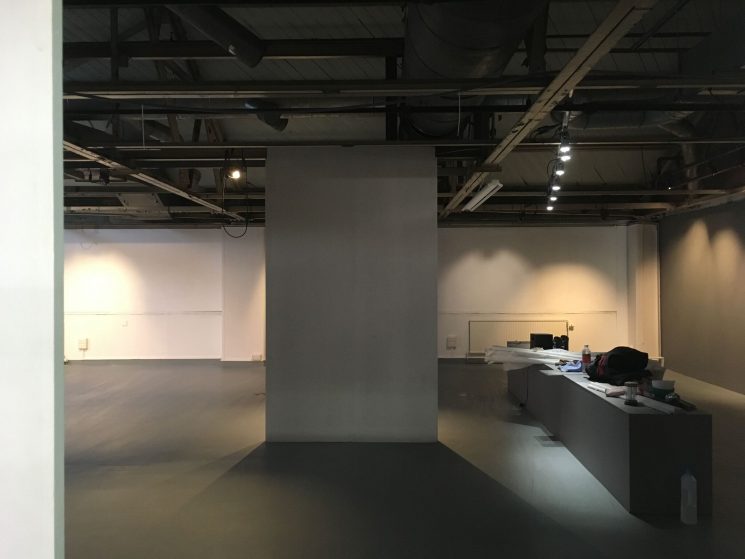
The Migration Museum at The Workshop, two days after ‘Call Me By My Name’ closed to the public.
In the four weeks between the two exhibitions, the rooms in our first-floor premises were completely reconfigured, the walls made good and repainted, new structures put on the window areas, new lighting installed, the floor repaired where necessary . . . oh, and the new exhibition installed, bringing together the work of twenty-odd artists, much of it commissioned specifically for this display (thanks to our generous sponsors).
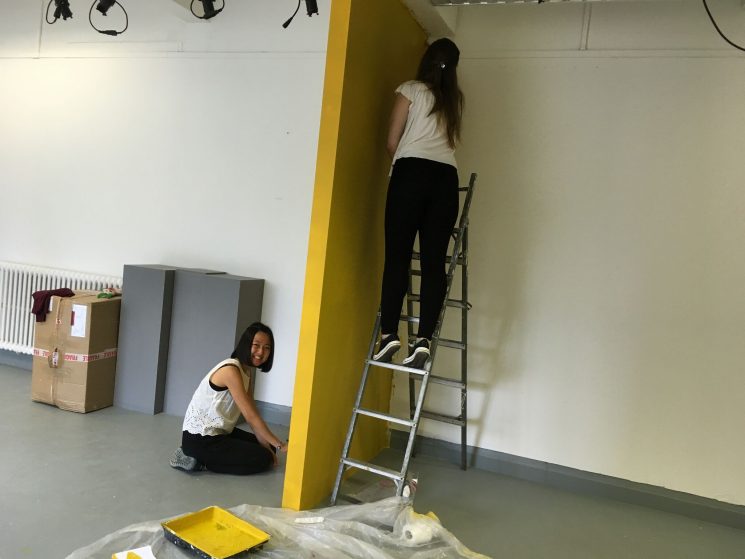
Koto Akyoshi and Ariadna Martinez (volunteers, both) working on the exhibition’s distinctive mustard paint.
Leaving to one side for the moment the fact that this exhibition was conceived, researched, commissioned and delivered within a mere nine months (an in-human gestation period), you have to wonder, ‘How was this possible?’
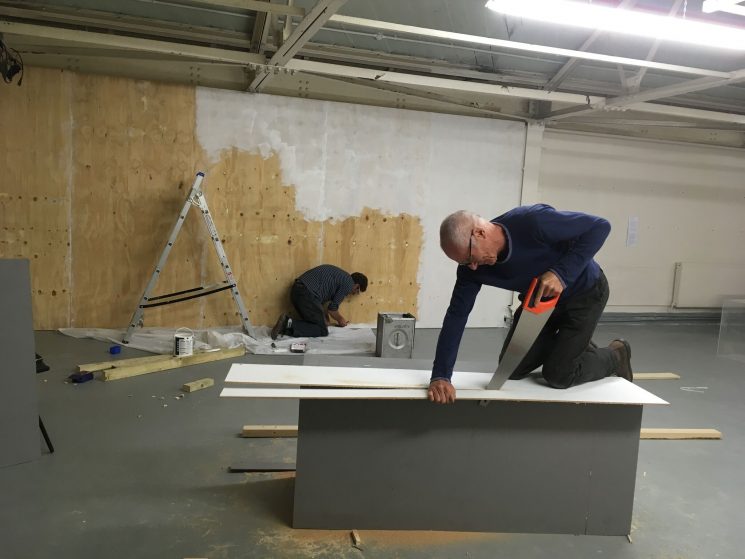
Andrew Steeds (MMP project manager) works on the new plinth for Roman Lokati’s sculpture, while Martin Cottis (joiner supremo) works in the background.
It’s a long roll-call, and it would be a mistake to get all Oscar-ceremony about it, but the most significant contribution outside our immediate team came from our volunteers. No doubt all charitable organisations depend on the goodwill of their volunteers, but the generosity of those who routinely turn up to staff our exhibitions, facilitate events and help us in the day-to-day running of our project is staggering. In addition, for No Turning Back, a large number of volunteers researched the seven historical moments that form the backbone of the exhibition, clarifying historical data, sourcing photographic and other records of the time, tracking down quotations to frame the display. And then many of them turned up to paint the museum and get the physical structure ready for the exhibition itself. This time the expression is absolutely true: we couldn’t have done it without them.
The two members of our team who were centrally responsible for putting the exhibition together (and whose current recuperation is therefore richly deserved) are Sue McAlpine and Aditi Anand. But Sue and Aditi would be the first to say that their work would have been impossible had it not been for the input not only of the volunteers just mentioned but also, crucially, that of our trustee Robert Winder and education committee member Martin Spafford, both of whom were instrumental in shaping the historical structure of No Turning Back.
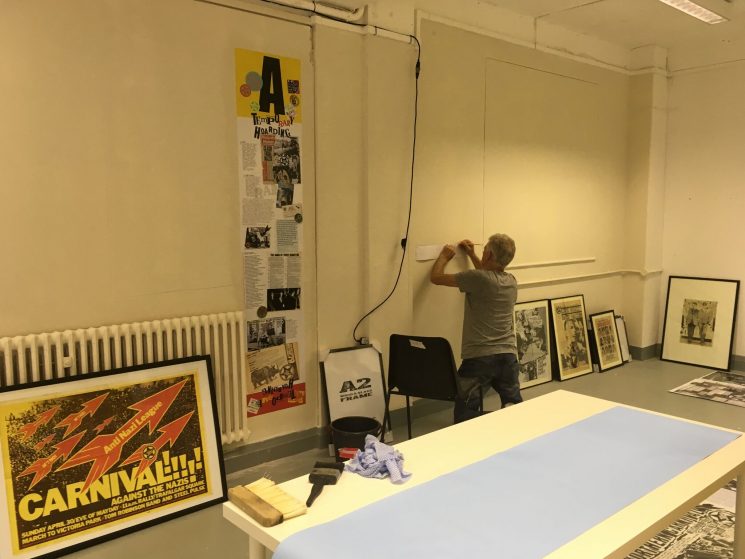
Andy Dark at work on the Rock Against Racism section of the exhibition.
However back-breaking it may be, this ability to assemble an exhibition in a period of time that most more-established institutions would find difficult has the huge advantage of allowing us to respond to current preoccupations while they are still viscerally significant. We were able to do that last year with Call Me By My Name, and all the signs are that we have done so again this year with No Turning Back. Conceived in the wake of the EU referendum debate, and the apparent schism in the country that it engendered, the current exhibition allows us to question whether this is a unique moment or whether in fact there have been previous pivotal points in our history that were equally significant to our attitude to influxes of people or to our engagement with the wider world.
Each moment, we hope, will be controversial, raise questions and provoke the occasional ‘I didn’t know that!’ moment. The historical starting point is the expulsion of the Jews in 1290, the only moment in British history – so far – when a complete race or religion was forcibly banished from the country. The other bookend is the 2011 Census, which revealed a dramatic growth in people self-identifying as mixed-race or mixed-heritage. In-between, there are five other moments (come and see for yourselves!) all of which have resonances for our current position. What happened? How did it happen? What was the human fall-out? What if something similar happened now . . . ? – these are some of the questions we hope will be raised by the display.
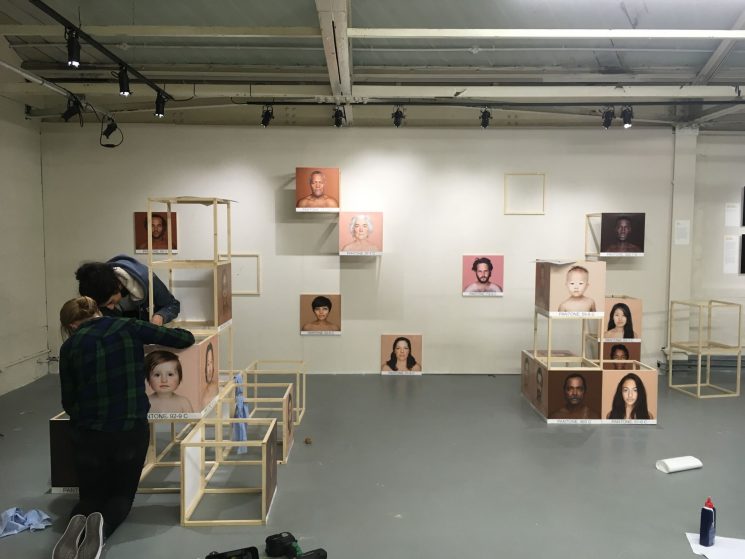
Emily Miller (MMP education officer) and Faiza Mahmood (MMP events co-ordinator) assembling Angelicá Dass‘s ‘Humanæ’ display; portraits Angelicá took of Lambeth and Southwark residents will be added to the display in October.
But this is not a dry academic account of seven moments in our history. The whole display is peopled by quotations, past and present, illustrating each theme, and on the floors and walls artists give their response to the events featured. The whole impression is history re-processed through a contemporary sensibility.
We hope the exhibition will get people thinking, discussing and arguing; and we plan to run a raft of events and activities that take the conversations forward. We have selected seven moments that seemed to us significant, but there is no suggestion, of course, that these are the only seven moments that could have been selected. Let us know the moments that you think we should have chosen. Eventually, we hope, all of them will be given due prominence in the permanent space to which our current temporary premises in Lambeth act as an inspirational curtain-raiser.
So we know now how we got the physical space from there to here, and huge thanks are due to everyone who helped in the process, all of whom went above and beyond. No Turning Back itself, of course, will ask the much more challenging questions: ‘How did we get here?’ and, more teasingly, ‘Where do we go from here?’
Thanks to our volunteers who helped us to set up and staff our current exhibition: Alastair Wiltshire, Alex Siu, Alice Lepage, Alizeh Hameed, Anna Marsden, Ariadna Martinez, Assunta Nicolini, Beatrice Burrows, Beth Taylor, Brenda Martinez, Beatrice Duguid Cox, Emily Rose Edwards, Gargie Ahmad, Holly Langham, Jasmine Jones, Jessica O’Connor-Tomlin, Jessica Lumanisha, John Gomez, Koto Akiyoshi, Kyriaki Kamenou, Lara Ertener, Maria Pintado, Max Evans, Mona Jamil, Naheed Bilgrimi, Nathan Evans, Rosa Evans, Sam Cumming, Sophie Rees Rumney, Tanya Costa and Uzma Ravat.


Leave a Reply